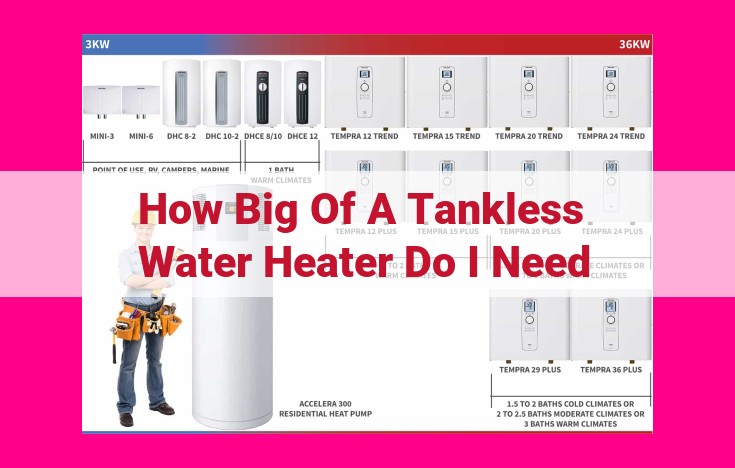Expert Guide To Selecting And Installing Tankless Water Heaters For Optimal Performance

When selecting a tankless water heater, consider factors influencing hot water demand (GPM, CFM, BTUH, # of bathrooms, occupants, appliances, ground temperature). Optimize design for efficient distribution by considering distance to fixtures, flow rate, pipe size, energy factor, and efficiency rating. Ensure safe and compliant installation by adhering to gas line size/pressure, electrical requirements, structural support, ventilation, and temperature/pressure relief valve guidelines.
Sizing Your Water Heater: Factors to Consider
- Explore the key factors that influence hot water demand, such as GPM, CFM, BTUH, number of bathrooms, occupants, appliance use, and ground temperature.
Sizing Your Water Heater: Essential Factors to Consider
When it comes to your home’s comfort and convenience, a properly sized water heater is crucial. Its capacity determines the uninterrupted flow of hot water you rely on for showers, baths, and household tasks. Understanding the key factors that influence hot water demand will help you make an informed decision.
Hot Water Demand Determinants:
- Gallons Per Minute (GPM): The rate at which hot water flows from a faucet. Higher GPM means more hot water available for simultaneous use.
- Cubic Feet Per Minute (CFM): The volume of air needed for combustion in gas-powered water heaters.
- British Thermal Units (BTUH): The measure of heat energy required to raise the temperature of water. Higher BTUH allows for faster heating.
- Number of Bathrooms: Each bathroom requires a dedicated flow of hot water, so the more bathrooms, the greater the demand.
- Occupants: The number of people living in the home directly impacts hot water consumption.
- Appliance Use: Dishwashers, washing machines, and clothes dryers all utilize hot water, increasing demand.
- Ground Temperature: In colder climates, ground temperature influences the amount of heat lost from pipes, requiring a larger water heater to compensate.
By considering these factors, you’ll ensure that your water heater meets your specific hot water needs, providing a comfortable and efficient experience in your home.
Optimizing Design for Efficient Water Distribution
When designing your plumbing system, efficient water distribution is crucial for ensuring a comfortable and cost-effective hot water experience. Here are key considerations to optimize your design:
Distance Between Water Heater and Fixtures
The closer your water heater is to your fixtures, the less heat loss occurs during distribution. Ideally, locate the water heater centrally within your home to minimize piping runs. Consider using a recirculation pump for homes with particularly long pipe runs.
Flow Rate Restrictions
Your pipe size and fixture choices can significantly impact water flow rates. Larger pipes and low-flow fixtures reduce pressure drops, allowing hot water to reach your fixtures faster and with less energy consumption. Select showerheads, faucets, and appliances that are WaterSense certified to promote water efficiency.
Pipe Size
The diameter of your pipes plays a vital role in water flow rates. Larger pipes allow for greater water volume and reduced friction losses, resulting in faster hot water delivery. Consult plumbing codes and industry standards to determine the appropriate pipe size for your specific application.
Energy Factor and Efficiency Rating
The energy factor (EF) and efficiency rating of your water heater indicate its energy efficiency. A higher EF and efficiency rating mean that the water heater converts more energy into hot water, reducing operating costs and environmental impact. Look for Energy Star certified water heaters to optimize energy consumption.
Ensuring Safe and Compliant Installation of Your Water Heater
When it comes to your water heater, safety should be your top priority. To ensure a safe and compliant installation, it’s crucial to consider the following essential requirements:
Gas Line Size and Pressure
For gas water heaters, the correct gas line size and pressure are essential for proper operation and safety. The gas line should be adequately sized to supply the required amount of gas to the water heater without causing pressure drops. Additionally, proper pressure is crucial to ensure efficient combustion and prevent potential hazards.
Electrical Requirements
Electrical water heaters require a dedicated circuit with the correct voltage and amperage. The wiring should be properly sized and protected by circuit breakers to prevent electrical overloads and potential fires. It’s also important to ensure that the water heater is properly grounded to avoid electrical shocks.
Structural Support
Proper structural support is crucial for the safe installation of your water heater. It should be securely fastened to the floor or wall with the correct mounting brackets and hardware. A level and stable base is essential to prevent the water heater from tipping over or causing structural damage.
Ventilation
Adequate ventilation is essential for proper combustion in gas water heaters and to prevent the buildup of dangerous gases. Ensure that the water heater is installed in a well-ventilated area with sufficient fresh air supply. Proper ventilation also helps prevent corrosion and extend the lifespan of the water heater.
Temperature and Pressure Relief Valve Considerations
Temperature and pressure relief valves (TPRVs) are critical safety devices that protect the water heater and plumbing system from excessive pressure and temperature buildup. Regular inspection and testing of the TPRVs is essential to ensure they are functioning properly. If a TPRV fails or becomes clogged, it can lead to dangerous pressure buildup and potential explosions.
By following these essential requirements, you can ensure that your water heater is installed safely and complies with all applicable codes and standards. Remember, a well-maintained and properly installed water heater is essential for the comfort, safety, and longevity of your home.